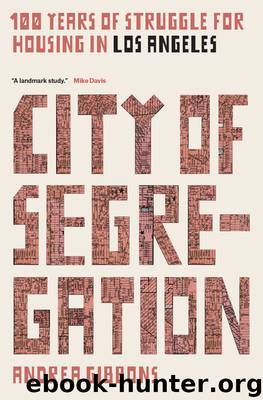City of Segregation by Andrea Gibbons

Author:Andrea Gibbons
Language: eng
Format: epub
Publisher: Verso Books
WHAT WAS WON AND WHAT WAS LOST
The victories of the post-World War II period partially destabilized the political and social supports for white space and privilege, and challenged widespread acceptance of white supremacist ideologies. The civil rights movement of the 1960s against Jim Crow brought this destabilization to a head, and for a moment, wholesale structural change seemed possible and revolution was in the air. Instead, a set of limited, however real, concessions were won. Openly expressed sentiments of white supremacy and biological racism have continued into the present, but the 1960s achieved their marginalization along with widespread acceptance of at least a generic political and social equality. The government legitimated this movement—forced by these victories to abandon its neutral stance on segregation, it actively (though with widely varying levels of willingness and effectiveness) began to support integration, taking measures to improve the position of oppressed “minorities” and prosecuting discrimination and hate crimes. Yet the economics of real estate continued to link race to both use and exchange values of land. Segregation only intensified with white flight, reflecting a dissonance between lip service to equal rights and loyalty to a community lived and understood in terms of race and segregated suburban neighborhoods.
Thus, despite these civil rights gains, new discourses of “freedom” and “color-blind” ideologies came together with the old real estate economics of land, where value continued to be defined by whiteness. This ensured that race remained central to the massive new suburban building programs that formed part of a new period of capital development centered on land speculation and real estate.37
Large developers made decisions about where the new racial faultlines would fall as they expanded into the suburbs. Older areas that were not seen as defensible (or worth defending)—such as Compton, with its heavy tax burden, integrated schools, and compromised position straddling the Alameda wall—were abandoned to peoples of color. Sales office staff and targeted advertising campaigns in Black newspapers like the Sentinel channeled them there and away from white areas. White homeowners, on the other hand, invested financially and emotionally in these neighborhoods, fought a tenacious and often violent rearguard action that ultimately—and most traumatically for families unwilling to live in integrated neighborhoods—failed to preserve their segregated nature. Resentment and a feeling of victimization became widespread—even among those successful in defending the whiteness and privilege of their neighborhoods.
The Torrance campaign showed homeowners themselves reaching for the rhetoric of civil rights and patriotism to defend their security and property values, prioritizing property rights over all else. CREA, too, consistently mobilized ideologies of the sanctity of property rights and a rhetoric of privatization and freedom, now opposed to a government that had betrayed it to support, even if only nominally, the same peoples of color that CREA had worked to protect neighborhoods from.
In the end, capital, resources, and most whites moved further into the suburbs, to newer, more defensible CIDs and gated communities, preferring the newly incorporated smaller cities with their well-protected tax bases. Thus, the connection between whiteness and
Download
This site does not store any files on its server. We only index and link to content provided by other sites. Please contact the content providers to delete copyright contents if any and email us, we'll remove relevant links or contents immediately.
| Anthropology | Archaeology |
| Philosophy | Politics & Government |
| Social Sciences | Sociology |
| Women's Studies |
Nudge - Improving Decisions about Health, Wealth, and Happiness by Thaler Sunstein(7261)
iGen by Jean M. Twenge(5167)
The Fire Next Time by James Baldwin(5025)
Adulting by Kelly Williams Brown(4243)
The Hacking of the American Mind by Robert H. Lustig(4094)
The Sports Rules Book by Human Kinetics(4081)
The Ethical Slut by Janet W. Hardy(4042)
Captivate by Vanessa Van Edwards(3733)
Mummy Knew by Lisa James(3523)
In a Sunburned Country by Bill Bryson(3376)
The Worm at the Core by Sheldon Solomon(3328)
Ants Among Elephants by Sujatha Gidla(3282)
Suicide: A Study in Sociology by Emile Durkheim(2908)
The Slow Fix: Solve Problems, Work Smarter, and Live Better In a World Addicted to Speed by Carl Honore(2845)
The 48 laws of power by Robert Greene & Joost Elffers(2818)
Humans of New York by Brandon Stanton(2694)
Handbook of Forensic Sociology and Psychology by Stephen J. Morewitz & Mark L. Goldstein(2606)
The Happy Hooker by Xaviera Hollander(2586)
The Tipping Point by Malcolm Gladwell(2566)
